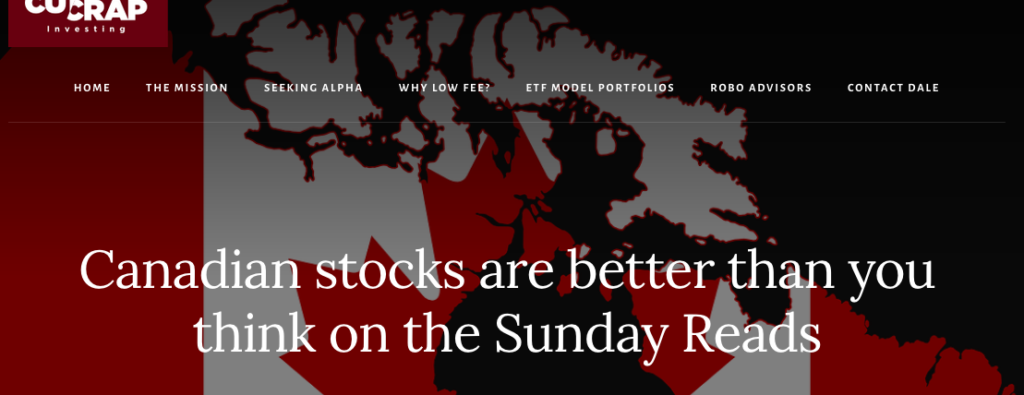By Dale Roberts
Special to Financial Independence Hub
For all of the headwinds and bad press for the Canadian economy, you’d think that the stock market was in a tailspin. But surprisingly, that’s not the case. The TSX Composite and TSX 60 are threatening to make new highs, eh. That’s as U.S. stocks make new high after new high. Given that, balanced portfolios and all-in-one asset allocation ETF portfolios are sailing. Canadian stocks are better than you think.
I am back after a week off. Late in March, I was driving to Florida and I had to change my Sunday morning travel plans, leaving early from Knoxville to make it to Clearwater for fun in the sun and taking in some Blue Jay spring training games.
My $2500 Jays Jersey – true story
Here’s the poster child for poor-performing big-dividend Canadian stocks.
A good summary of the struggling Bell Canada (BCE). Investors might have to wait 2 or 3 years to see that debt under control – and the dividend covered. Rate cuts would/will help the cause. Bell has been a victim of poor to unfair regulation, increased competition and higher borrowing costs.
Even perma Bull Brian Belski of BMO is cautious so say the least. From a Globe & Mail piece:
“We believed sentiment was resoundingly negative and becoming worse. As we approach the end of the first calendar quarter of 2024, we maintain the view that analysts and investors remain overly cautious – fundamental metrics such as earnings, valuation, and operating performance in several areas are showing definitive signs of troughing.
There has been a lot of negative sentimenet towards the Canadian economy, and we likely transfer that emotion to our opinion of the Canadian stock market.
And while the big-dividend space in Canada has been struggling, or at least lagging, the TSX Comp and TSX 60 is on a very nice run. Here are the 5-year returns.

Quite often, stocks like to climb that ‘wall of worry.’ That’s why market timing simply does not work. The markets can have a mind of their own, and they are forward looking. It would be like planning your day’s activities based on next week’s weather forecast.
That’s a total return of over 60% over the last 5 years, and 118% over the last 10 years. Hardly struggling.
Vanguard VDY vs the market
And while the big divs are struggling thanks to the higher rate environment, this long-term chart shows investors have still been rewarded, handsomely.

The returns are almost identical from VDY inception, just over 10 years ago. And surprisingly, from 2020 (when the world changed with the first modern day pandemic that unleashed an inflationary period) VDY is outperforming the market.
There may be another lesson here in consistency and staying the course. That said, readers will know that I am a big fan of the broader Canadian Wide Moat stock model, compared to an exclusive big-dividend model. And look to the more-moats option that includes lower-yielding grocers, railways plus picks of Brookfield and Couche-Tard.
In ETF form the wide moat model follows closely to the BMO Low Volatility ETF – ticker ZLB. That may be Canada’s best option for covering the Canadian space. It has much more sensible sector allocation, and that has contributed to the market beat. I promise to update the returns for the ZLB post shortly.
Another low-volatility stock model
Norman Rothery tracks some wonderful Canadian portfolio models at the Globe & Mail. Here are the current holdings for his market-crushing low-volatility stock portfolio.
ATCO, BCE, Bank of Nova Scotia, CN Railway, Canadian Utilities, Dollarama, Enbridge, Fortis, Great-West Lifeco, Hydro One, Intact Financial, Metro, Power Corp, Pembina Pipeline, Rogers Sugar, Royal Bank of Canada, Sun Life Financial, TD Bank, Waste Connections, TMX Group.
That is a very good stock mix, and with lots of overlap to the wide moat and BMO Low Volatility models. I will be adding Waste Connections as a “pick” for the wide moat model.
More Sunday Reads
At MoneySense Jonathan Chevreau is getting ready to convert his RRSP to a RRIF. That’s mandated of course, at age 71. A Canadian then has to start receiving payments at age 72. If you miss the conversion, your RRSP will be liquidated and you’ll likely face a massive tax bill. Jon provides a very good RRIF overview in that post.
At My Own Advisor Mark considers a common debate – pay down that mortgage or invest? The simple math suggests that the better option is the one that creates the greater AFTER TAX return. Capital appreciation on your principle residence is tax free. There is no perfect answer as future returns are unknown and future borrowing costs are unknown. All said, it’s hard to go wrong paying down debt, and at least accelerating your mortgage payments.
That said, historical returns for an aggressive investment portfolio will beat real estate returns over time. And of course, those who are in a fortunate position with ample free cash flow will be paying down debt and building up their investment portfolios. It’s usually a choice on which side gets more attention.
We first attacked the mortgage
If you are concentrating on eliminating that mortgage, make sure you have a very robust emergency fund. The home equity of course is not a liquid asset. We do need to be ready for life’s curveballs. My wife and I concentrated on quickly reducing our first mortgage (as we invested modest amounts). That set the table for our net-worth build. Once the mortgage was a minor concern we moved to aggressively building up the investment portfolios. It worked for us, and the emotional component comes into play. We did not want to have a big mortgage hanging over our heads, at any time.
For weekly reads and podcasts Banker on Wheels might be your first stop. Included in the mix is a look at the valuation levels for the Magnificent 7 that have largely been driving stock returns in the U.S.
At BOW you’ll also find a video from a couple that is one step closer to FIRE – Financial Independence Retire Early.
Power Corporation
Dividend Hawk’s weekly review includes an overview of Power Corp’s financial results. That is a popular stock for Canadians who create their own stock portfolio.
At the Retirement Manifesto Fritz offers investment lessons from Lewis & Clark. The parallels:
- A journey into the unknown.
- The journey included elements of danger.
- Preparation was critical for success.
- Self-sufficiency was required.
- Once underway, it was tough to turn back.
- There were unexpected developments en route.
- The expedition was a success.
Another fine read from Fritz.
And one of my favourites in the oil and gas space …
I love my big 4 in CNQ, IMO, TOU and SU. Inflation protection, and my gas bill is more than paid for when we travel. There is no risk of oil prices spikes putting a damper on any car trip or flight travel plans. The higher oil prices go, the more you make. It’s that simple.
A word from Dividend Daddy
Thanks for reading. Don’t forget to follow this blog. Enter your email address in the Subscribe area. No charge.
 Dale Roberts is the owner operator of the Cut The Crap Investing blog. A former ad guy and investment advisor and occasional columnist for MoneySense, Dale helps Canadians say goodbye to paying some of the highest investment fees in the world. This blog originally appeared on Cut the Crap Investing on March 24, 2024 and is republished on the Hub with permission.
Dale Roberts is the owner operator of the Cut The Crap Investing blog. A former ad guy and investment advisor and occasional columnist for MoneySense, Dale helps Canadians say goodbye to paying some of the highest investment fees in the world. This blog originally appeared on Cut the Crap Investing on March 24, 2024 and is republished on the Hub with permission.


